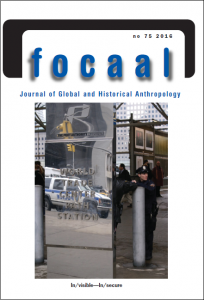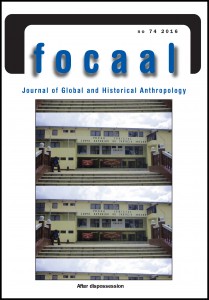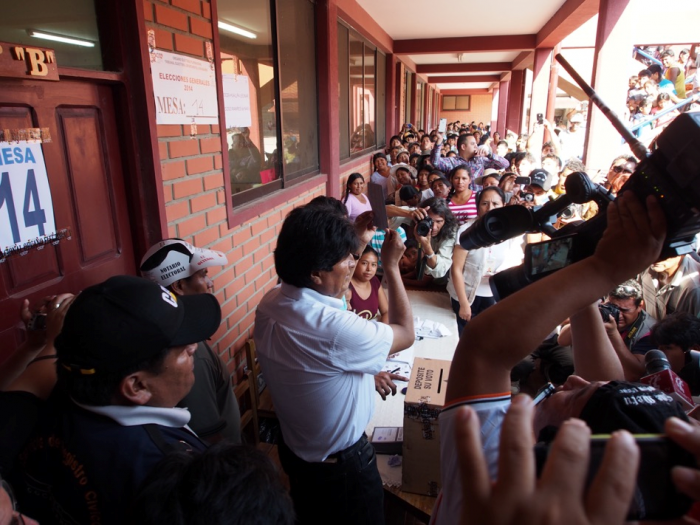 We are pleased to announce that the latest issue of Focaal – Journal of Global and Historical Anthropology has recently published and is available online at its new home, www.berghahnjournals.com/focaal.
We are pleased to announce that the latest issue of Focaal – Journal of Global and Historical Anthropology has recently published and is available online at its new home, www.berghahnjournals.com/focaal.
Zoë Goodman: What’s the point of the “Mauss haus”? The Gift and anthropology today
On 30 April 2016, a group of anthropological heavyweights congregated at the School of Oriental and African Studies (SOAS, University of London), under the aegis of a workshop entitled “The gift that keeps on giving.” The workshop, organized to launch Jane Guyer’s expanded edition of Marcel Mauss’s The Gift (2016), brought into being the third English translation of this much-cited text. As the latest offering from open-access publishing house HAU Books, the event also marked the start of a partnership between HAU and the SOAS Centre for Ethnographic Theory (CET).
Continue reading
Mariya Ivancheva: The revolution will not be criticized? The (im)possibility of left-wing critique in Venezuela
This post is part of a series on the Latin American pink tide, moderated and edited by Massimiliano Mollona (Goldsmiths, University of London).
After heading the pink tide in Latin America, the Bolivarian government in Venezuela has most recently experienced significant challenges (Bolton 2016). With oil prices sinking, inflation skyrocketing, and consumption goods chains being blocked by commercial networks sympathetic of the opposition, the government has started losing support in its base. Gloating over power cuts and “food shortages”—or more accurately, deficits of certain consumables—opposition-supporting international and Venezuelan private media are hysterically preparing for a pyrrhic victory of the free market over socialism. Scandalized by ever-stronger reactions against Dilma Rouseff’s presidency in Brazil, Venezuelan government supporters home and abroad take an ever more defensive stance shielding the government from internal and external critique alike.
Continue reading
Focaal Volume 2016, Issue 74: After dispossession
 We are pleased to announce that the latest issue of Focaal – Journal of Global and Historical Anthropology has recently published and is available online at its new home, www.berghahnjournals.com/focaal.
We are pleased to announce that the latest issue of Focaal – Journal of Global and Historical Anthropology has recently published and is available online at its new home, www.berghahnjournals.com/focaal.
This issue’s theme section, titled “After dispossession” and guest edited by Oscar Salemink and Mattias Borg Rasmussen, addresses how seemingly global processes become entangled in local affairs in sub-Saharan Africa, a former Soviet republic, and Latin America. The editors’ introduction is available to all readers for free, and “Reclaiming the lake” is also temporarily free as a part of Berghahn’s Earth Day virtual issue.
Focaal 74 also includes a regular articles section and a forum piece by FocaalBlog’s very own Edward Simpson. As always, forums are freely available to all readers.
Volume 2016, Issue 74: After Dispossession
Guest Editors: Oscar Salemink and Mattias Borg Rasmussen
THEME SECTION
After dispossession: Ethnographic approaches to neoliberalization
Oscar Salemink and Mattias Borg Rasmussen
Reclaiming the lake: Citizenship and environment-as-common-property in highland Peru
Mattias Borg Rasmussen
Infrastructures of progress and dispossession: Collective responses to shrinking water access among farmers in Arequipa, Peru
Astrid Oberborbeck Andersen
Enemies of the people: Theorizing dispossession and mirroring conspiracy in the Republic of Georgia
Katrine Bendtsen Gotfredsen
Foregrounding possibilities and backgrounding exploitation in transnational medical research projects in Lusaka, Zambia
Birgitte Bruun
ARTICLES
“Communists” on the shop floor: Anticommunism, crisis, and transformation of labor in Bulgaria
Dimitra Kofti
Humanitarian mine action in Burma/Myanmar and the reterritorialization of risk
Ken MacLean
It was horrible, but we live now: The experience of young German adults in everyday encounters with the Holocaust
Lisa J. Krieg
FORUM
Is anthropology legal? Earthquakes, blitzkrieg, and ethical futures
Edward Simpson
Recommend Focaal to your library
As a key researcher in your field, you can recommend Focaal to your library for subscription. A form for this purpose is provided on the Focaal website here.
Ines Hasselberg: Enduring Uncertainty: Deportation, Punishment and Everyday Life
Enduring Uncertainty is a volume of the “Dislocations” series published by Berghahn Books. The immense dislocations and suffering caused by neoliberal globalization, the retreat of the welfare state in the last decades of the twentieth century, and the heightened military imperialism at the turn of the twenty-first century have raised urgent questions about the temporal and spatial dimensions of power. Through stimulating critical perspectives and new and cross-disciplinary frameworks, which reflect recent innovations in the social and human sciences, this series provides a forum for politically engaged, ethnographically informed, and theoretically incisive responses.
Continue reading
Marina Gold: The end of the pink tide: Cuba
This post is part of a series on the Latin American pink tide, moderated and edited by Massimiliano Mollona (Goldsmiths, University of London).
Does Obama’s visit herald the end of the Cuban Revolution?
On Thursday, 18 December 2014, I received an urgent WhatsApp message from a Cuban friend, who was then in Spain with his Spanish girlfriend.[1]
“Pon CNN ahora mismo! Se acaba el bloqueo.” (Turn on CNN now! The blockade is over.)
Thomas Grisaffi: After the Referendum: Evo Morales and the Movement Towards Socialism
This post is part of a series on the Latin American pink tide, moderated and edited by Massimiliano Mollona (Goldsmiths, University of London).
In February 2016 Bolivian President Evo Morales, an indigenous Aymara and former coca grower, lost his bid to amend the Constitution to allow him to stand for a third consecutive term. This was a blow to Morales, who has won re-election twice (in 2009 and 2014), and has triumphed in two previous referendums. Commentators saw the defeat as evidence that the pink tide in Bolivia is receding. But such evaluations are premature; 49 percent of the population still voted in favor of the amendment, and while members of the “no” camp might want to see change at the top, they don’t necessarily want a return to neoliberal orthodoxy. The Morales administration has experienced its fair share of corruption, conflict, division, and poor planning, but on balance most Bolivians have done better under a left-leaning government.
Chris Hann: On Saxony-Anhalt bashing
Regional elections in Germany have seldom if ever attracted as much attention as they did on Sunday, 13 March 2016. This was the first opportunity for the electorate to express its opinion about the “refugee policy” pursued by Chancellor Angela Merkel since early September 2015. Not only her own Christian Democratic Union but also the Social Democrats, her coalition partner in Berlin, lost votes to a new protest party, the Alternative for Germany. These “Rechtspopulisten” did especially well in Saxony-Anhalt, where I live. Rather than simply join the chorus of condemnation of this vile movement and celebrate the humanitarian altruism shown by the mainstream parties toward deserving foreigners, it behooves social scientists to analyze the deeper causes and consequences of both the voting and the migration patterns.
Continue reading
Iselin Åsedotter Strønen: After the Bolivarian Revolution: What’s in store for Margarita?
This post is part of a series on the Latin American pink tide, moderated and edited by Massimiliano Mollona (Goldsmiths, University of London).
I still clearly remember Margarita,[1] the first “Bolivarian activist” I got to know in Venezuela. It seems so long ago now. For more than ten years, I have followed what I in my mind envisage as the rise and fall of the Bolivarian Revolution’s golden years as seen from the grassroots’ perspective. My first encounter with President Hugo Chávez’s Venezuela was in the fall of 2005, when I as a master’s student in Anthropology of Development came to Caracas for the first time. Through a friend of an acquaintance of an acquaintance, I was brought to the barrio (shantytown) of La Vega to meet with a group of women engaged in a housing and infrastructure project through the recently established Committees for Urban Housing (Comités de Tierra Urbana).
Continue reading
Judith Beyer & Felix Girke: Naypyitaw: Rescaling materiality, capitalizing space
Since 2012, we have carried out twelve months of urban anthropological research in Yangon, Myanmar’s largest city and its economic and cultural center. Until February 2016, however, we had not once visited the country’s capital, Naypyitaw, a planned city of immense size. It had not been a priority for our work, but we also had not been really keen on visiting: when the former military government began to relocate the capital in November 2005, away from cosmopolitan, multireligious, multiethnic Yangon, located at the mouth of the Andaman Sea, to a previously more or less vacant inland area, most commentators had been dismissive, bemused, or outraged.
Continue reading
